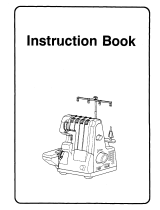
Please note that on disposal, this product must be safely
recycled in accordance with relevant National legislation
relating to electrical/electronic products. If in doubt please
contact your retailer for guidance.
This householdsewing machine is designed to comply with IEC/EN 60335-2-28 and UL 1594
IMPORTANT SAFETY INSTRUCTIONS
When using an electrical appliance, basic safety precautions should always be followed, including the following:
Read all instructions before using this household sewing machine.
DANGER - To reduce the risk of electric
shock:
• A sewing machine should never be left unattended when plugged in. Always unplug this sewing machine from
the electric outlet immediately after using and before cleaning.
• Always unplug before relamping. Replace bulb with same type rated 5 Watt.
WARNING - To reduce the risk of burns,
fi re, electric shock, or injury to persons:
•
This sewing machine is not intended for use by persons (including children) with reduced physical, sensory or
mental capabilities, or lack of experience and knowledge, unless they have been given supervision or instruc-
tion concerning use of the sewing machine by a person responsible for their safety.
• Children should be supervised to ensure that they do not play with the sewing machine.
•
Use this sewing machine only for its intended use as described in this manual. Use only attachments
recommended by the manufacturer as contained in this manual.
•
Never operate this sewing machine if it has a damaged cord or plug, if it is not working properly, if it has been
dropped or damaged, or dropped into water. Return the sewing machine to the nearest authorized dealer or
service center for examination, repair, electrical or mechanical adjustment.
•
Never operate the sewing machine with any air openings blocked. Keep ventilation openings of the sewing
machine and foot controller free from the accumulation of lint, dust, and loose cloth.
•
Keep fi ngers away from all moving parts. Special care is required around the sewing machine needle.
• Always use the proper needle plate. The wrong plate can cause the needle to break.
•
Do not use bent needles.
•
Do not pull or push fabric while stitching. It may defl ect the needle causing it to break.
•
Switch the sewing machine off (“0”) when making any adjustment in the needle area, such as threading needle,
changing needle, threading bobbin, or changing presser foot, etc.
• Always unplug sewing machine from the electrical outlet when removing covers, lubricating, or when making
any other user servicing adjustments mentioned in the instruction manual.
•
Never drop or insert any object into any opening.
•
Do not use outdoors.
•
Do not operate where aerosol (spray) products are being used or where oxygen is being administered.
•
To disconnect, turn all controls to the off (“0”) position, then remove plug from outlet.
•
Do not unplug by pulling on cord. To unplug, grasp the plug, not the cord.
•
Keep fi ngers away from moving parts, especially the area near the blades.
SAVE THESE INSTRUCTIONS
For the USA and Canada
This sewing machine has a polarized plug (one blade wider than the other). To reduce the risk of electric shock,
this plug is intended to fi t in a polarized outlet only one way. If the plug does not fi t fully in the outlet, reverse the
plug. If it still does not fi t, contact a qualifi ed electrician to install the proper outlet. Do not modify the plug in any
way.





















